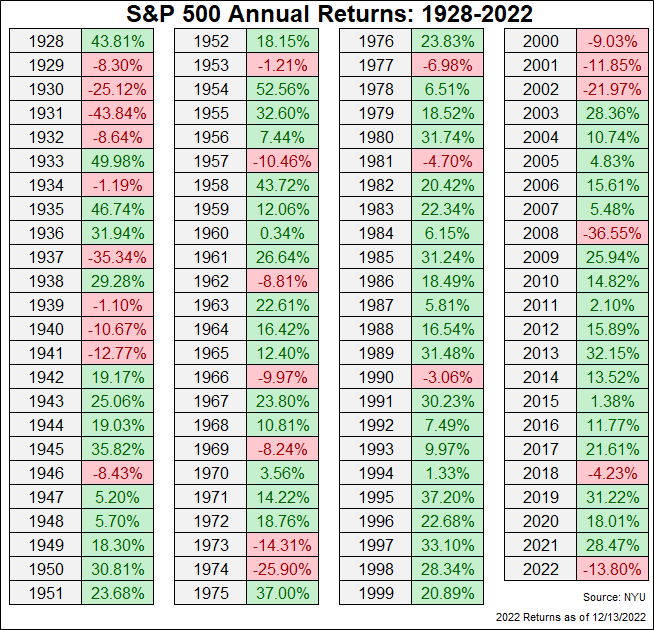Dear fellow investors,
It’s no secret that 2022 was a turnip of a year (my apologies to turnips).
All that red and the related lack of “green” perhaps has you down or discouraged about this whole “investing” thing.
To that, I offer some hope. Taken from the excellent “A Wealth of Common Sense” blog, we see the following year-by-year track record for the U.S. stock market, as measured by the S&P500:

You can see that most years are in the green, and even when they’re not, it’s rare to see the market chalk up consecutive negative numbers. Indeed, there are only four occasions in the past 95 years where the market pulled back-to-back “red” returns, all of which I’d suggest had something “else” contributing to the prolonged downturns:
- 1929 to 1932: The Great Depression was in full swing.
- 1939 to 1941: Something about a world war and the associated uncertainty?
- 1973 and 1974: Exiting a period of “elevated” valuations (Google the “Nifty Fifty”) and running smack into an oil crisis and runaway inflation (and associated skyrocketing interest rates); and
- 2000 to 2002: The bursting of the Tech Bubble (another period of “enthusiastic” valuations) and associated recession.
Even if you believe that the 1973 to 1974 and 2000 to 2002 periods with the blow-off/grind down of elevated valuations are the more appropriate comparators for what we’re living through today (and, for the record, this is my presumption), there is much to be excited about, I think.
For one, look at the long-term returns in that annual return table. If you do the math (spoiler: I have), you’ll see that U.S. stocks are up 6,566-fold over this near century of market returns. Annualized, this amounts to 9.70% before dividends; you can probably tack on two or three percentage points to this number for such payouts.
For another, observe the healing power of steady growth and long-term thinking. Imagine you were unfortunate enough to have put all your money into an S&P-tracking index fund at the end of 1999. Three years later, you had lost (on paper) three-eighths of your money. You just clawed your way back above even when 2008’s global credit crisis showed up, and, by the end of that year, you were back to 28% below your cost basis of nine years prior. Since 2008, four of the 14 years (including the not-yet-concluded 2022) have brought us negative returns.
And yet, would you like to speculate on what your investments — made at the end of 1999 in this example remember — the pinnacle of late-90’s Tech Bubble excess — would be worth today? It would be about 4.2 times what you put in on New Year’s Eve 1999 — 6.44% annualized, even after living through the bubble bursting, global financial crisis, and whatever 2022 was.
Then consider what dollar-cost averaging into the market over these years would have brought. Investing an equal amount of money at the end of every year into the index from 1999 through 2021 (a total of 23 equal contributions) would today be worth about 3.5 times your total contributions, an annualized 9.4% (again before dividends) for all contributions.
The takeaways, I think, are these:
- The market goes up over time, and it goes up more years than it goes down. Yes, 2022 kinda sucked (and maybe 2023 will as well). But 10 or 15 years from now, today’s pain will be forgotten, and all signs point to equity values being higher.
- Even when the market goes down; even if it’s a rare string of down years, time heals such wounds. Call this a variant of “time in the market, not timing the market”
- Use downturns to your advantage — adding money when stocks and markets are down leads to higher overall returns with the benefit of a long-time horizon.
To this last point, I humbly suggest you turn your attention to the best Canadian stocks my colleagues and I think you can buy today.
Onward!








